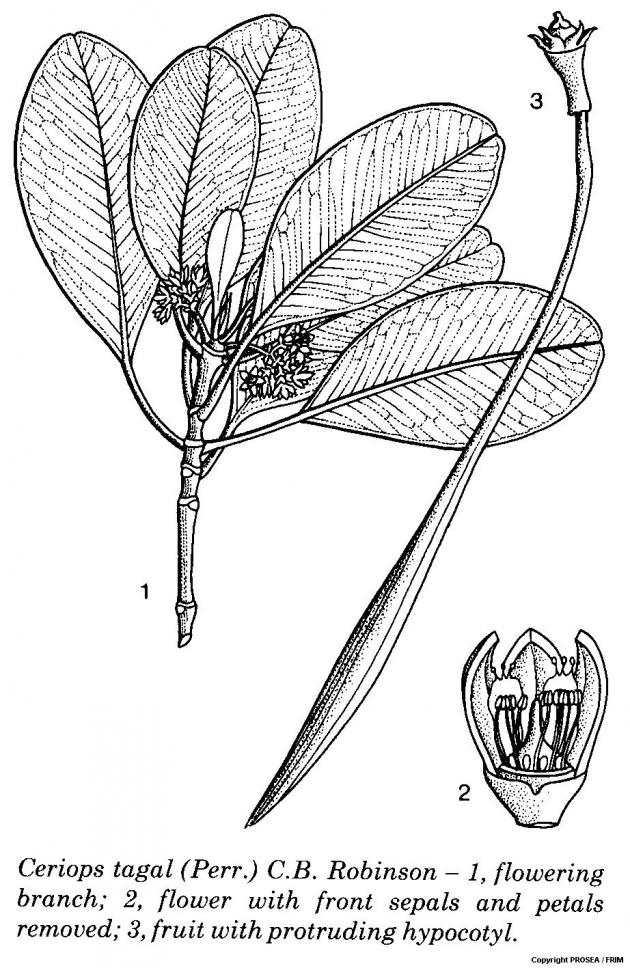Scientific Name
Ceriops tagal (Perr.) C.B.Rob.
Synonyms
Bruguiera arnottiana Wight ex Arn., Bruguiera timoriensis Wight & Arn., Ceriops boviniana Tul., Ceriops candolleana Arn., Ceriops forsteniana Blume, Ceriops globulifera Boreau ex Tul., Ceriops lucida Miq., Ceriops mossambicensis Klotzsch, Ceriops pauciflora Benth., Ceriops somalensis Chiov., Ceriops timoriensis Domin, Ceriops timoriensis (DC.) C.A.Gardner, Rhizophora tagal Perr., Rhizophora timoriensis DC. [1]
Vernacular Name
| Malaysia | Tengar [2][3][4] |
| English | Yellow mangrove, spurred mangrove [3] |
| China | Jian zi shu , jiao guo mu, hai jia zi, hai dian zi [3] |
| Indonesia | Tengar (Sumba); tanggala tutu (Gorontalo); tingi (East Kutei, Java) [2][3] |
| Thailand | Prong (Samut Sakhon, Chanthaburi); prong daeng (Samut Sakhon); samae (Peninsular) [2][3] |
| Brunei | Tengar [2] |
| Singapore | Tengar [2] |
| Philippines | Tangal (Tagalog, Bisaya); tongog (Bisaya); sambali-rongon (Ilokano) [2]; prong, prong deng, plong me [4] |
| Cambodia | Smaè [2][3] |
| Vietnam | Dzà vôi, dzà dò [2] |
Geographical Distributions
It is not known where this plant widespread and common species originated, but it is now found on coasts from East Africa to the Indian subcontinent, then through tropical Asia to Australia and the Pacific. It extends as far as Hong Kong, Taiwan, Yap and Palau in the north-western Pacific, and the Bismarck Archipelago, the Solomon Islands and northern New Caledonia in the south-western Pacific, with an eastern limit on Malakulu Island in the New Hebrides. However, fossils indicate that the species once had a greater range. Ceriops tagal is commonly found along the coasts throughout Southeast Asia. [2] Although C. tagal reaches its greatest stature in forests in the seasonal high rainfall regions, it is more important ecologically, where seasonal climates prevail. Typically, it occupies sites from the middle to the landward zones of mangrove forests, and may be flooded either by all normal high tides, or only by occasional high tides. [2]
Botanical Description
C. tagal comes from the family of Rhizophoraceae. It is a tree of variable form, attaining exceptionally a height of 40 m, the trunk is 40 cm in diametre with a slender stem and a compact crown in favourable sites, but in poorer conditions, the tree is small dimensions or even shrub-like. [2]
The stem base is usually surrounded by a tightly appressed conical cluster of short stilt roots. The bark varies from white and pale grey to reddish-brown and deeply fissured in older specimens. The branches are conspicuously jointed. [2]
The leaves are arranged opposite, clustered at the end of the twigs, coriaceous, obovate to obovate-oblong, rarely elliptic-oblong, measuring 5-12 cm x 2-7.5 cm, wedge-shaped at the base, obtuse or slightly emarginate at the apex, hairless and glossy. The petiole is 1.5-3.5 cm long and deciduous stipules are 1-2.5 cm long at the base. [2]
The flowers are 3-5 mm long in condensed up to 10-flowered cymes on the terminal nodes of new shoots and with 5-6-merous, with deeply lobed sepal and white. The petals are about 3.5 mm long, coherent at the base and with 3 clavate and apical at the appendages. The stamens are twice the number of sepal lobes. The anthers are much shorter than the filaments and explosively dehiscent. The ovary is 3-celled and semi-inferior. [2]
The fruit is an ovoid berry, measures 1.5-2.5 cm long,with persistent reflexed sepal lobes, pointed basally and warty over its whole length. [2]
The seeds are viviparous. The hypocotyl is 15-25(-35) cm long, club-shaped, protruding below the fruit but still attached to the tree and often deeply fluted. [2]
The roots are superficial, spreading and with looping or knobby pneumatophores in wet situations, but some deeply descending roots may develop from the stem base. [2]
Cultivation
C. tagal may become dominant in well drained zones, and forms dense low-canopied pure stands along the landward boundaries of some mangrove swamps, where the soil surface may become dry and cracked. However, these belts of C. tagal become open and stunted where salinity is high. In extreme situations, the trees give way to open herbaceous areas or to bare saline mudflats. [2]
Chemical Constituent
No documentation
Plant Part Used
No documentation
Traditional Use
No documentation
Preclinical Data
No documentation
Clinical Data
No documentation
Poisonous Management
No documentation
Line Drawing

References
- The Plant List. Ver1.1. Ceriops tagal (Perr.) C.B.Rob.[homepage on the Internet]. c2013 [updated 2012 Apr 18; cited 2015 Apr 28]. Available from: http://www.theplantlist.org/tpl1.1/record/kew-2712632
- Hughes RH, Sukardjo S. Ceriops tagal (Perr.) C.B. Robinson In: Lemmens RHMJ, Wulijarni-Soetjipto N, editors. Plant Resources of South-East Asia No. 3: Dye and tannin-producing plants. Wageningen, Netherlands: Pudoc Scientific Publishers, 1991; p. 65-67.
- Philippine Medicinal Plants. Tañgal. Ceriops tagal (Perr.) C.B. Robinson. [homepage on the internet] c2014. [updated 2013 Nov; cited 2015 Apr 29] Available from http://www.stuartxchange.org/Tangal.html
- Herbal Medicine Research Centre, Institute Medical Research. Compendium of Medicinal Plants Used in Malaysia. Volume 1. Kuala Lumpur: HMRC IMR; 2002. p.162.


